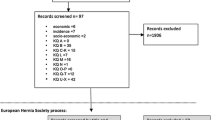Abstract
Background
Umbilical and epigastric hernias are common in the adult population and prompt repair is advised. We aimed to evaluate the impact of concomitant rectus diastasis on the outcome of patients who underwent primary sutured fascia closure of a hernia without mesh.
Methods
We performed a retrospective analysis of 231 consecutive adult patients who had undergone elective suture-based repair of small (<2 cm) and primary umbilical or epigastric hernias with respect to complications, recurrence, and chronic pain.
Results
Patients with rectus diastasis suffered from a significantly increased rate of hernia recurrence (29/93 vs. 9/108; p < 0.001). The use of absorbable sutures also had a negative influence on the recurrence rate (26/90 vs. 12/111; p = 0.001). Obesity (body mass index > 35 kg/m2) was associated with more complications (p = 0.02). Wound infections following hernia repair also were associated with a higher rate of recurrence (p = 0.08) and chronic pain (p = 0.02). The mean follow-up via a structured questionnaire was 31 months (range 3–59) and data were available for 201 of 231 patients (87 %).
Conclusion
We strongly recommend preoperatively checking for rectus diastasis and using nonabsorbable sutures as an alternative to mesh repair only when repairing small umbilical or epigastric hernias (<2 cm) and there is no concomitant rectus diastasis. Patients with coexistent rectus diastasis definitely benefit from mesh-based repair of the midline to decrease the recurrence rate.
Similar content being viewed by others
References
Jackson OJ, Moglen LH (1970) Umbilical hernia. A retrospective study. Calif Med 113(4):8–11
Hjaltason E (1981) Incarcerated hernia. Acta Chir Scand 147(4):263–267
Arroyo Al, García P, Pérez F et al (2001) Randomized clinical trial comparing suture and mesh repair of umbilical hernia in adults. Br J Surg 88(10):1321–1323
Christoffersen MW, Helgstrand F, Rosenberg J et al (2013) Lower reoperation rate for recurrence after mesh versus sutured elective repair in small umbilical and epigastric hernias. A nationwide register study. World J Surg 37(11):2548–2552. doi:10.1007/s00268-013-2160-0
Venclauskas L, Silanskaite J, Kiudelis M (2008) Umbilical hernia: factors indicative of recurrence. Medicina (Kaunas) 44(11):855–859
Schumacher OP, Peiper C, Lörken M et al (2003) Long-term results after Spitzy’s umbilical hernia repair. Chirurg 74(1):50–54 [in German]
Muysoms FE, Bontinck J, Pletinckx (2011) Complications of mesh devices for intraperitoneal umbilical hernia repair: a word of caution. Hernia 15(4):463–468
Ponten JE, Leenders BJ, Charbon JA et al (2014) Mesh Or Patch for Hernia on Epigastric and Umbilical Sites (MORPHEUS trial): study protocol for a multi-centre patient blinded randomized controlled trial. BMC Surg 14(1):33
Hickey F, Finch JG, Khanna A (2011) A systematic review on the outcomes of correction of diastasis of the recti. Hernia 15(6):607–614
Dalenbäck J, Andersson C, Ribokas D et al (2013) Long-term follow-up after elective adult umbilical hernia repair: low recurrence rates also after non-mesh repairs. Hernia 17(4):493–497
Muysoms FE, Miserez M, Berrevoet F et al (2009) Classification of primary and incisional abdominal wall hernias. Hernia 13(4):407–414
Fachinelli A, Maciel Trindade MR (2007) Qualitative and quantitative evaluation of total and types I and III collagens in patients with ventral hernias. Langenbecks Arch Surg 392(4):459–464
Luijendijk RW, Lemmen MH, Hop WC et al (1997) Incisional hernia recurrence following “vest-over-pants” or vertical Mayo repair of primary hernias of the midline. World J Surg 21(1):62–65. doi:10.1007/s002689900194
Westen ML, Christoffersen MW, Jorgensen LN et al (2014) Chronic complaints after simple sutured repair for umbilical or epigastric hernias may be related to recurrence. Langenbecks Arch Surg 399(1):65–69
Acknowledgments
The author thanks the study nurses who helped in data acquisition and data management. The kind statistical support of Mag. Michael Stumpner is greatly acknowledged.
Conflicts of interest
Gernot Köhler has no conflicts of interest or financial ties to disclose.
Author information
Authors and Affiliations
Corresponding author
Rights and permissions
About this article
Cite this article
Köhler, G., Luketina, RR. & Emmanuel, K. Sutured Repair of Primary Small Umbilical and Epigastric Hernias: Concomitant Rectus Diastasis Is a Significant Risk Factor for Recurrence. World J Surg 39, 121–126 (2015). https://doi.org/10.1007/s00268-014-2765-y
Published:
Issue Date:
DOI: https://doi.org/10.1007/s00268-014-2765-y




